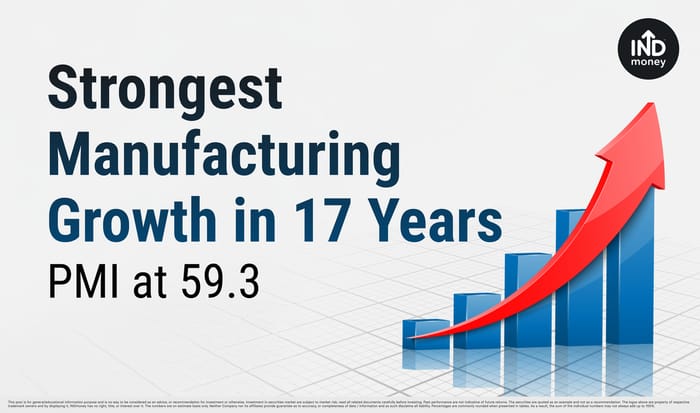
- What is PMI and Why Does It Matter?
- August 2025 PMI – Key Insights
- Why This Matters for India’s Economy
- Disclaimer
India’s manufacturing sector is showing strong momentum. The Manufacturing Purchasing Managers’ Index (PMI) for August 2025 stood at 59.3, up from 59.1 in July, the highest level in more than 17 years.
Why does this matter? Because PMI is more than just a number. It acts like an early signal of economic health, telling us if production activity has gained momentum, demand is rising, and whether the overall economy is strengthening.
In this blog, we’ll break down what PMI means, how it is calculated, and what the latest data tells us about India’s manufacturing growth and its impact on the economy.
What is PMI and Why Does It Matter?
The Purchasing Managers’ Index (PMI) is like a monthly “report card” for the manufacturing sector. It’s a leading indicator, meaning it gives a glimpse of future trends rather than just reporting past performance.
Here’s how it works:
- Survey-based: Each month, about 400 manufacturing companies across India are surveyed.
- Who answers? Purchasing managers, the people who handle raw materials, orders, and supplies, share if their business activity is better, the same, or worse than last month.
- Weightage: Their responses are combined into a single score using five main components:
| Component | Weightage | What It Tracks |
| New Orders | 30% | Are businesses getting more or fewer orders compared to last month? |
| Output (Production) | 25% | Is production increasing or decreasing? |
| Employment | 20% | Are factories hiring more people or cutting jobs? |
| Suppliers’ Delivery Times | 15% | Are raw materials arriving faster or slower? (Inverted, as slower deliveries often mean higher demand) |
| Stocks of Purchases | 10% | Are companies buying and stocking more raw materials? |
The final number is easy to read:
- Above 50 = expansion (factories are busier, demand is strong).
- Below 50 = contraction (factories are slowing down).
This is why PMI is closely tracked by investors, policymakers, and businesses alike.
August 2025 PMI – Key Insights
1. PMI Climbs to 59.3, Highest in 17 Years
- The index rose from 59.1 in July to 59.3 in August, the strongest improvement in 17-and-a-half years.
- Production volumes grew at the fastest pace in nearly five years, supported by better supply-demand alignment.
2. New Orders at 57-Month High, Exports Ease on US Tariffs
- New domestic orders continued to rise strongly, matching July’s 57-month high.
- Export orders rose, but growth was the weakest in five months, as the US raised tariffs on Indian goods to 50%, dampening demand from American buyers.
3. Intermediate Goods Lead Growth, Consumer Goods Lag
- The intermediate goods sector saw the strongest growth.
- Capital goods (like machinery and equipment) followed.
- Consumer goods showed growth too, but at a slower pace compared to the other categories.
4. Hiring Streak Extends to 18 Months
- Employment rose for the 18th straight month, though the pace was the weakest since November 2024.
- This still shows manufacturers’ willingness to expand their workforce despite some cooling in the hiring rate.
5. Raw Material Buying at 16-Month High
- Firms stepped up their purchases of raw and semi-finished materials at the fastest rate in 16 months, far above the long-term average.
- This indicates strong confidence in sustained demand.
6. Inventories Rise After Nine Months of Decline
- Input inventories grew at the second-quickest pace since April 2024.
- Finished goods inventories finally increased, ending a nine-month depletion streak.
7. Input Costs Moderate, But Selling Prices Jump
- Input costs rose for items like bearings, minerals, steel, and small electronic parts, but overall inflation stayed below the long-run average.
- Selling prices, however, increased at the fastest pace in three months, reflecting strong demand.
8. Business Confidence Recovers After July’s Low
- Optimism about future output bounced back in August, reversing July’s three-year low in sentiment.
- Manufacturers expect output to keep expanding over the next 12 months
Why This Matters for India’s Economy
A PMI of 59.3 is a clear sign that India’s manufacturing engine is running strong. Despite global challenges like higher tariffs and softer export orders, domestic demand is acting as a powerful cushion.
This resilience in manufacturing doesn’t just benefit factories, it supports growth in sectors like logistics, trade, and services, creating a broader ripple effect in the economy.
Disclaimer
Investments in the securities market are subject to market risks, read all the related documents carefully before investing. The securities are quoted as an example and not as a recommendation.This is nowhere to be considered as an advice, recommendation or solicitation of offer to buy or sell or subscribe for securities. INDStocks SIP / Mini Save is a SIP feature that enables Customer(s) to save a fixed amount on a daily basis to invest in Indian Stock. INDstocks Private Limited (formerly known as INDmoney Private Limited) 616, Level 6, Suncity Success Tower, Sector 65, Gurugram, 122005, SEBI Stock Broking Registration No: INZ000305337, Trading and Clearing Member of NSE (90267, M70042) and BSE, BSE StarMF (6779), SEBI Depository Participant Reg. No. IN-DP-690-2022, Depository Participant ID: CDSL 12095500, Research Analyst Registration No. INH000018948 BSE RA Enlistment No. 6428. Refer https://indstocks.com/pricing?type=indian-stocks; https://www.indstocks.com/page/indian-stocks-sip-terms-and-condition for further details.